The fracking oil and gas industry sure knows how to ring in the New Year. Welcome to 2017, oh ye folks who are attempting to navigate Wetzel County roads!
To politely describe the oil-and-gas-industry created traffic problems I encountered on January 4 and 5, I can only come up with terms such as “haphazard” and “uncoordinated” and “chock-full of bad judgment.” (See the highlighted sections in the “BLANKET PERMIT FOR OVERSIZE AND OVERWEIGHT VEHICLES” pdf included at the end of this post.)
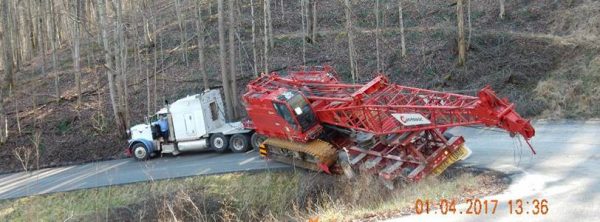
The Manitowoc Crane, above, on a Mid-East Trucking (MET) over-sized, loaded truck blocked Route 89 near Silver Hill in Wetzel County for about seven hours on January 4. I know, because I was stuck behind it. The over-sized truck was on its way to the Harlan Well Pad (in southern Marshall County), operated by Southwestern Energy (SWN), which had contracted with MET for the crane’s delivery. The crane would be used to load tucks with sections of the drill rig, which was being dismantled after it use on the Harlan pad. MET drivers would then move the drill rig to another site.
Because we had plenty of time to chat after the incident pictured above, I learned that this driver had never been on this road before, which makes no sense to me. Surely MET knows that these West Virginia roads are narrow, winding, steep and dangerous. Surely MET would have the sense, or SWN would advise them, to have drivers who are going to be hauling such massive and important loads to at least first do a trial run with an empty truck. A little practice is useful.
At about 12:20, the driver and crane left the staging area, out on Route 7, near my mailbox. Most SWN traffic reports to the staging area to await dispatch to assorted nearby deep shale drilling and fracking-related operations.
At 12:35, as the rig headed north on Brock Ridge Road, the driver encountered the first of several escorted large trucks hauling silica sand, coming in the opposite direction.
What were these other large trucks even doing on the road at the same time? Why weren’t the drivers informed that this massive, over-sized crane-hauling truck was on its way to another SWN fracturing operation. SWN’s traffic coordinator—if there is one—should have absolutely made sure that every big truck was off Brock Ridge, and not getting even close to the crane until it was in an area where other big trucks could easily pass it. Instead, the driver of the crane met three large “sand box” trucks coming at him around sharp, blind bends, as in this, the first such encounter, pictured below.
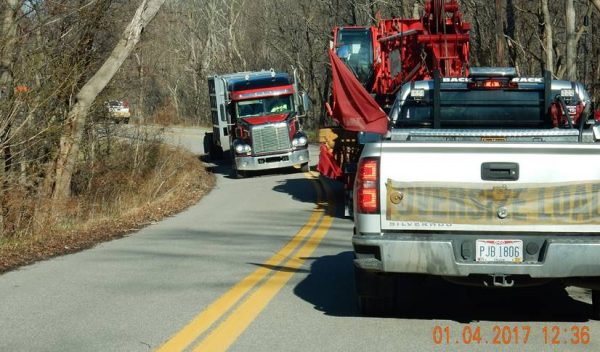
Immediately behind the crane (and me in my vehicle) are two more sand boxes. SWN seems to be just begging for a traffic problem by running all these big trucks so close together. The sand boxes behind us had to pull off and wait, which caused congestion behind them.
As the crane got to the bottom of a 14% grade, there were three more sand boxes, all parked (two of which are pictured just below). At least the drivers had been alerted to wait there, but behind them, local traffic was also stopped.
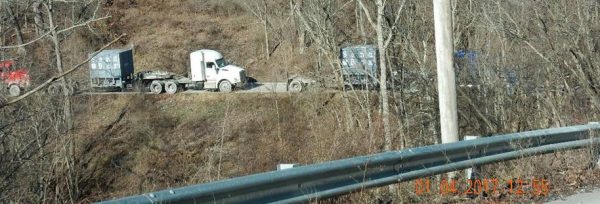
At 1:02 p.m., the crane encountered another long tractor trailer near a bridge (see photo below). At this point both trucks had to yield some to allow passage of the crane.
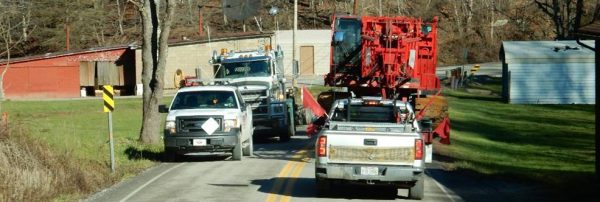
This journey has become an example of what flying blind must be like—never quite know what is coming around the bend. Remember, this driver had never been here before. I thought he was getting rattled, as a string of traffic, both SWN and local, grew behind us.
1:10 p.m. The driver comes across another surprise, an uphill switchback in the road. Things don’t go too badly. After multiple back-ups and wiggling around and more back-ups, at 1:17, the driver was almost around the turn. By 1:22, he navigated the turn. Only 12 minutes lost. No problem, except all other traffic coming the other direction kept moving. It seems that no one thought to keep all SWN traffic off the road and out of the way. Maybe, next time.
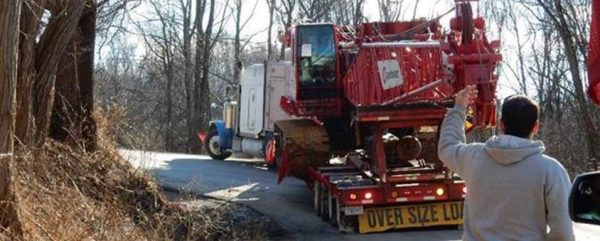
In just a few hundred feet, we met an escorted flatbed truck and two other vehicles. Then at 1:27, our crane driver encounters yet another over-sized truck coming at him. Truly the left hand does not know what the left hand is doing here. Why do we have escort vehicles? Why are CB radios available? When these aren’t used effectively, things get haphazard and un-coordinated! It is really important to get this crane to the Harlan Well Pad, or not? Apparently not, just some experimenting going on here… The crane driver has to move over, so the other truck, coming off the Harlan, can pass. And still, the SWN dump trucks are behind us.
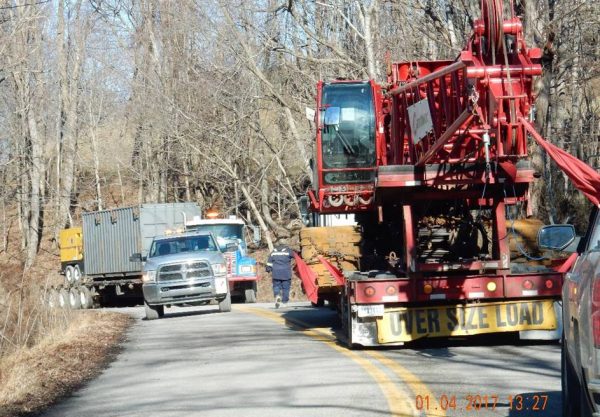
1:33 p.m. The crane almost goes over the hill (refer back to top photo), which is where all the traffic sits until at least 8:30 p.m., which is when I was finally able to leave the scene. I don’t know at what time the road was finally fully open.
I do know that the next day, January 5 brought more traffic headaches for the citizens of Wetzel County, the truck drivers, and any unfortunate visitors to our area.
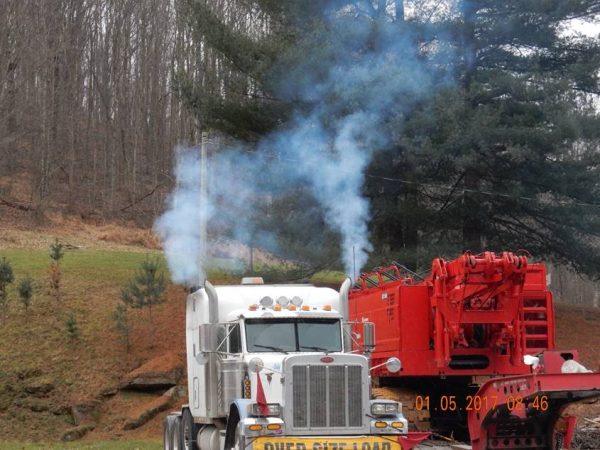
The crane and the tractor hauling it parked over night at the Silver Hill Fire Department, and, perhaps in thanks for the accommodations, blasted diesel fumes into the morning air.
As the day wears on, the roads are getting slick from some winter weather (which tends to occur in January). Drivers of escort vehicles jam the CB channels with chatter: The roads are getting slick. Can we get a cinder truck here? There is an early school let out; school bus curfew is at 12:30 [when the permitted over-sized loads are supposed to clear the roads so the buses can pass; see pdf below].
Meanwhile, at the Harlan Well Pad, the driver of an oversize MET truck is ignoring the CB chatter, the snowfall, and the restrictions of the his state permit. He leaves the pad and gets on the public road at 11:45 a.m. On the CB, the driver expresses his concern, saying he is slipping on the paved section of the road. The driver comes to an area where I assumed he would pull off due to the slippery roads, the snow and early bus curfew. But, he continues on and comes to regret that.
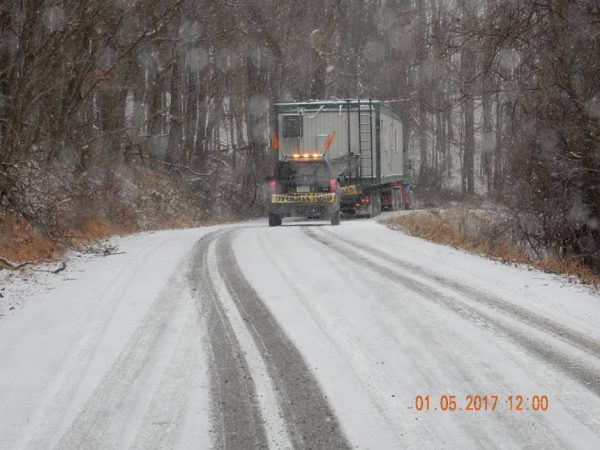
While the driver commented on the slippery road, he had no idea how close he came to a repeat of the incident with the crane the day before. In the two pictures just below, note the back wheel location. Partially off the road—close call!
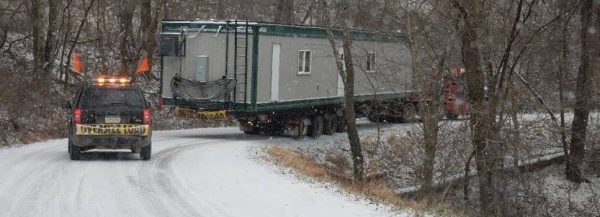
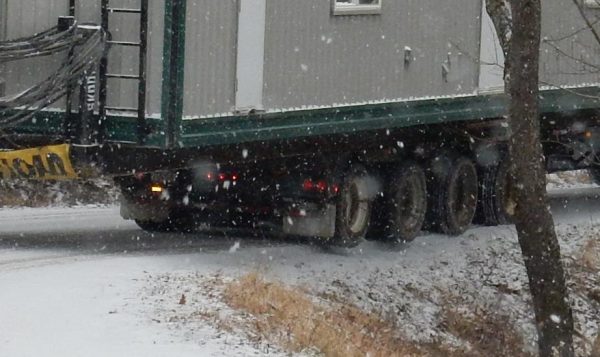
The driver arrived at an intersection of three roads, where he needed to turn left, but could not negotiate the turn (see the photo below). He called in help to pull the back end around. He only had the road blocked for 30 minutes. Good compared to the day before. Major improvement, complete with a little more diesel fumes for the neighborhood.
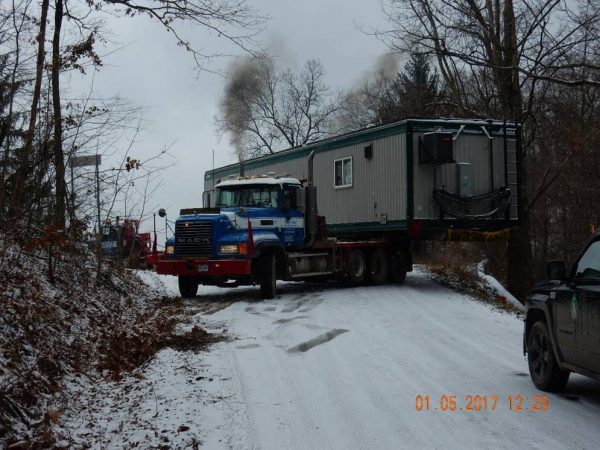
As you will see in the “BLANKET PERMIT FOR OVERSIZE AND OVERWEIGHT VEHICLES” pdf below, the West Virginia Department of Transportation (WVDOT) does not allow travel of oversize vehicles when roads are made dangerous due to snow and ice, etc. Another bullet dodged—no WVDOT inspector in the neighborhood.
After this incident, I left Silver Hill, but the day’s traffic problems on Brock Ridge Road weren’t over yet. Around 3:30 or so a sand box had a problem on the hill with the 18% grade. Apparently, the driver tried to shift gears on the hill and broke a drive shaft.
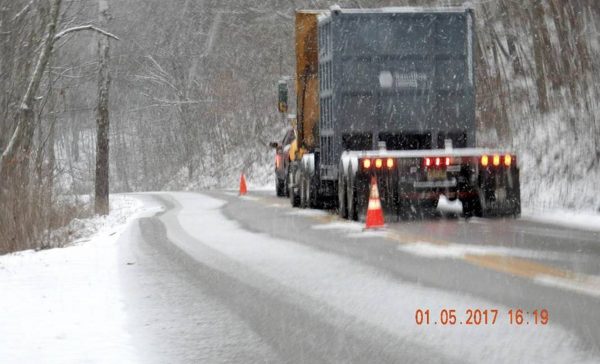
Just another day in the gas fields of Wetzel County.



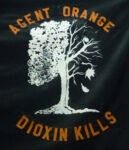
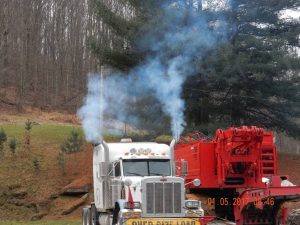






Great post, pics, and research with the pdf. Thanks!